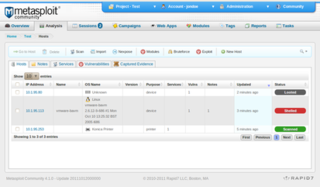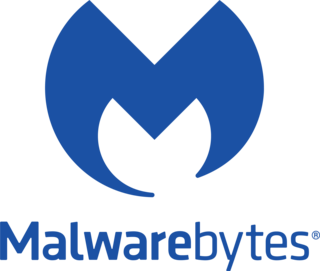Telnet is a client/server application protocol that provides access to virtual terminals of remote systems on local area networks or the Internet. It is a protocol for bidirectional 8-bit communications. Its main goal was to connect terminal devices and terminal-oriented processes.

In computing, a denial-of-service attack is a cyber-attack in which the perpetrator seeks to make a machine or network resource unavailable to its intended users by temporarily or indefinitely disrupting services of a host connected to a network. Denial of service is typically accomplished by flooding the targeted machine or resource with superfluous requests in an attempt to overload systems and prevent some or all legitimate requests from being fulfilled.
A vulnerability scanner is a computer program designed to assess computers, networks or applications for known weaknesses. These scanners are used to discover the weaknesses of a given system. They are utilized in the identification and detection of vulnerabilities arising from mis-configurations or flawed programming within a network-based asset such as a firewall, router, web server, application server, etc. Modern vulnerability scanners allow for both authenticated and unauthenticated scans. Modern scanners are typically available as SaaS ; provided over the internet and delivered as a web application. The modern vulnerability scanner often has the ability to customize vulnerability reports as well as the installed software, open ports, certificates and other host information that can be queried as part of its workflow.

Nmap is a network scanner created by Gordon Lyon. Nmap is used to discover hosts and services on a computer network by sending packets and analyzing the responses.
In the context of information security, and especially network security, a spoofing attack is a situation in which a person or program successfully identifies as another by falsifying data, to gain an illegitimate advantage.
A port scanner is an application designed to probe a server or host for open ports. Such an application may be used by administrators to verify security policies of their networks and by attackers to identify network services running on a host and exploit vulnerabilities.

AVG AntiVirus is a line of antivirus software developed by AVG Technologies, a subsidiary of Avast, a part of Gen Digital. It is available for Windows, macOS and Android.
Security Administrator Tool for Analyzing Networks (SATAN) was a free software vulnerability scanner for analyzing networked computers. SATAN captured the attention of a broad technical audience, appearing in PC Magazine and drawing threats from the United States Department of Justice. It featured a web interface, complete with forms to enter targets, tables to display results, and context-sensitive tutorials that appeared when a vulnerability had been found.

Bulletproof hosting (BPH) is technical infrastructure service provided by an Internet hosting service that is resilient to complaints of illicit activities, which serves criminal actors as a basic building block for streamlining various cyberattacks. BPH providers allow online gambling, illegal pornography, botnet command and control servers, spam, copyrighted materials, hate speech and misinformation, despite takedown court orders and law enforcement subpoenas, allowing such material in their acceptable use policies.
OpenVAS is the scanner component of Greenbone Vulnerability Management (GVM), a software framework of several services and tools offering vulnerability scanning and vulnerability management.

The Metasploit Project is a computer security project that provides information about security vulnerabilities and aids in penetration testing and IDS signature development. It is owned by Boston, Massachusetts-based security company Rapid7.
A network telescope is an Internet system that allows one to observe different large-scale events taking place on the Internet. The basic idea is to observe traffic targeting the dark (unused) address-space of the network. Since all traffic to these addresses is suspicious, one can gain information about possible network attacks as well as other misconfigurations by observing it.
On computer networks, a service scan identifies the available network services by attempting to initiate many sessions to different applications with each device in a target group of devices. This is done by sending session initiation packets for many different applications to open ports on all of the devices specified in the target group of devices. This scan is done across a wide range of TCP, UDP. A service scanner will identify each device it finds along with the services that it finds on the ports that it scans.

An idle scan is a TCP port scan method for determining what services are open on a target computer without leaving traces pointing back at oneself. This is accomplished by using packet spoofing to impersonate another computer so that the target believes it's being accessed by the zombie. The target will respond in different ways depending on whether the port is open, which can in turn be detected by querying the zombie.
SAINT is computer software used for scanning computer networks for security vulnerabilities, and exploiting found vulnerabilities.
A device fingerprint or machine fingerprint is information collected about the software and hardware of a remote computing device for the purpose of identification. The information is usually assimilated into a brief identifier using a fingerprinting algorithm. A browser fingerprint is information collected specifically by interaction with the web browser of the device.

Malwarebytes is anti-malware software for Microsoft Windows, macOS, ChromeOS, Android, and iOS that finds and removes malware. Made by Malwarebytes Corporation, it was first released in January 2006. This is available in a free version, which scans for and removes malware when started manually, and a paid version, which additionally provides scheduled scans, real-time protection and a flash-memory scanner.
Network enumeration is a computing activity in which usernames and info on groups, shares, and services of networked computers are retrieved. It should not be confused with network mapping, which only retrieves information about which servers are connected to a specific network and what operating system runs on them. Network enumeration is the discovery of hosts or devices on a network. Network enumeration tends to use overt discovery protocols such as ICMP and SNMP to gather information. It may also scan various ports on remote hosts for looking for well known services in an attempt to further identify the function of a remote host. The next stage of enumeration is to fingerprint the operating system of the remote host.
Logjam is a security vulnerability in systems that use Diffie–Hellman key exchange with the same prime number. It was discovered by a team of computer scientists and publicly reported on May 20, 2015. The discoverers were able to demonstrate their attack on 512-bit DH systems. They estimated that a state-level attacker could do so for 1024-bit systems, then widely used, thereby allowing decryption of a significant fraction of Internet traffic. They recommended upgrading to at least 2048 bits for shared prime systems.

J. Alex Halderman is professor of computer science and engineering at the University of Michigan, where he is also director of the Center for Computer Security & Society. Halderman's research focuses on computer security and privacy, with an emphasis on problems that broadly impact society and public policy.








